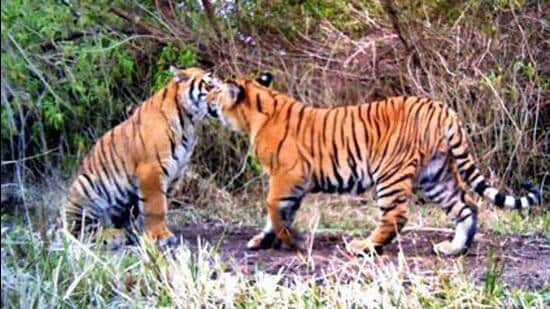Bengaluru

The number of tigers in the state, assessed through the trap camera method, has increased to 435 in 2022, compared to 404 in 2018, according to the Karnataka Forest Department.
Prior to the International Tiger Day on Saturday, the Forest Minister Eshwar Khandre on Thursday released the figures of the All-India Tiger Estimation (AITE) exercise 2022. The forest department in the state in had conducted tiger estimation exercise in all the 37 forest divisions across 31 districts in 2022.
However, the actual numbers will be known on Saturday when the Ministry of Environment, Forests and Climate Change and the Wildlife Institute of India release the all-India tiger census report. In 2018, Karnataka ranked second in tiger numbers with 524, while Madhya Pradesh bagged the top spot with 526.
According to the figures, out of the five tiger reserves in the state, the Nagarahole Tiger Reserve has reported the highest number of tigers at 149, followed by the Bandipur Tiger Reserve (BTR) with 143 tigers.
Meanwhile, the Biligira Ranga Temple (BRT) Tiger Reserve has reported 39 tigers, Bhadra Tiger Reserve has 26 tigers and Kali Tiger Reserve 19 tigers.
According to the report, there were 4,786 camera trap locations across the 37 forest divisions. The total number of camera trap images captured during the exercise was 66,86,450.
Releasing the number, Khandre thanked the two late Prime Ministers Rajiv Gandhi and Indira Gandhi for their contributions to forests in the country. “They implemented the Forest Protection Act, Wildlife Protection Act and Forest Right Act, and helped conserve forests for the current generation,” he said.
Meanwhile, noted tiger biologist and conservationist Ullas Karanth, appreciated the survey done by the forest department. “Unlike in the previous surveys from 2006 onwards, when the reports were published by NTCA, which were non-transparent on many details, the present Karnataka report provides significantly more details on the implementation of the camera trap surveys conducted by the department during the year in 2021-2022. We hope this sets a new trend of transparency as opposed to earlier practices of the NTCA,” Karanth said.
Further suggestion some measures for improvement, Karanth said, “The report contains the numbers of individual, unique adult tigers photo-captured at various sites which look reasonable to us, provided all these animals were camera trapped during July-August 2022. Furthermore, they have reported closed model tiger density estimates for several of the camera trapped sites. These densities look reasonable, provided closure was maintained.”
“The total estimated numbers of tigers in sampled areas could also have been generated in date on ‘state space’ area and delineation of tiger habitats had been clearly presented in the report. An issue of concern, which can be addressed if more detailed information can be provided, pertains to compliance with the important assumptions of geographic and temporal closure of populations during the sampling,” he said.
Karanth pointed out that the other gap in the report is the lack of data on population turn over because of the once-in-four-year survey frequency imposed by the NTCA prescriptions. “If on the other hand, the more rigorous protocols for open model population dynamics approached that we developed as far back as 2006 had been implemented, in addition to other numbers, critical population dynamic parameters vital to comprehensive monitoring, such as annual population growth rates, survival rates, recruitment rates and movement parameters could all have been estimated.”


